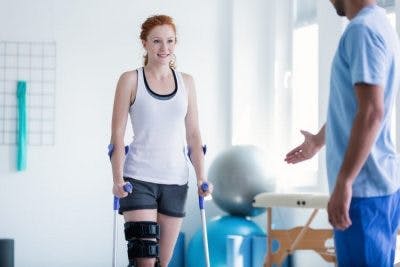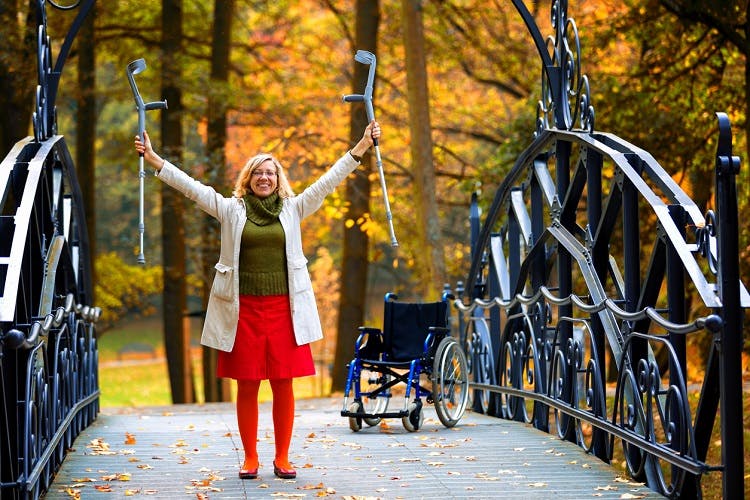Many factors play a role in regaining the ability to walk after a spinal cord injury. Fortunately, it is possible for many SCI survivors.
There is potential to walk again after SCI because the spinal cord has the ability to reorganize itself and make adaptive changes called neuroplasticity. With an effective rehabilitation plan and consistency, individuals may be able to promote neuroplasticity to optimize their mobility.
To help you understand how to walk again after spinal cord injury, this article will address:
- How long does it take to walk after spinal cord injury?
- The chances of walking again after paralysis
- How incomplete vs complete SCI affects walking
- Treatments to walk again after a spinal cord injury
- Recovery stories of SCI survivors who relearned how to walk
How Long Does It Take to Walk After Spinal Cord Injury?
Because every spinal cord injury and its recovery are unique, the timing of recovery will vary from person to person. It’s suggested that the most physical recovery occurs within the first 6 months after a spinal cord injury because the spinal cord experiences a heightened state of neuroplasticity during that time.
Neuroplasticity is the central nervous system’s ability to make adaptive changes and rewire itself based on an individual’s behaviors. Consistently practicing a skill helps the spinal cord perceive a demand for that function and encourages it to adapt.
However, that does not mean recovery is limited to those 6 months. The central nervous system never runs out of neuroplasticity, so as long as it is being stimulated through repetitive movement, there is potential to recover.
For some individuals with spinal cord injuries, learning how to walk takes longer because the spinal cord has experienced swelling. When inflammation decreases, healing and movement may develop.
Many factors can affect how long it takes to recover walking after a spinal cord injury, including the location and severity of injury, diet, pre-existing health conditions, mental health, and physical activity levels. Think of your recovery holistically. Taking care of your overall health will help you physically and mentally prepare to pursue rehabilitation.
Chances of Walking Again After Paralysis

Level of injury refers to the lowest region of the spinal cord where motor control or sensation are not affected. Because signals from the brain cannot travel past spinal cord damage, all functions below the level of injury may be affected. As a result, higher levels of injury are associated with more widespread paralysis, which is why learning to walk again may take longer for some individuals.
For example, an SCI near your neck may leave you paralyzed from the neck down. Rather than recovering the ability to walk, individuals with this type of spinal cord injury may focus on recovering arm and hand functions first in order to be more independent with self-care activities such as feeding and dressing themselves.
However, if you injure a lower area of the spinal cord, the upper body may not be affected. Therefore, rehabilitative therapy may focus on overall body strengthening and endurance as well as a return to walking, often with assistive devices.
Another factor that significantly affects one’s chances of walking again after paralysis is the severity of their spinal cord injury. One way to classify the severity of injury is to determine whether it is complete or incomplete.
How Incomplete vs Complete SCI Affects Walking
Incomplete SCIs indicate that spared neural pathways exist. Spared neural pathways refer to connections between the brain and areas below the level of injury that are not damaged.
Spared neural pathways play an essential role in predicting recovery outcomes because damaged neurons in the spinal cord cannot regenerate or utilize neuroplasticity. As a result, the more spared neural pathways an individual has within the spinal cord, the better their chances of recovery.
In contrast, a complete injury results in no spared neural pathways. Because there is no way for signals from the brain to reach areas below the level of injury after a complete SCI, individuals with incomplete SCIs are more likely to walk again than those with complete injuries.
Treatments to Walk Again After a Spinal Cord Injury
Because every spinal cord injury and its recovery are unique, a personalized treatment plan focused on the ability to walk again will be most effective.
Below, we’ll discuss various treatment interventions that may be involved in recovering walking after a spinal cord injury.
1. Physical Therapy
Physical therapy is the foundation and starting point of regaining walking after a spinal cord injury. The more aggressively you pursue physical therapy, the greater your chances of recovery.
In order to recover walking after SCI, you must retrain the brain, spinal cord, and muscles to work in sync again through highly repetitive and task-specific movement. The more you practice, the stronger the neural pathways get and the more familiar the movements become.
Addressing leg strength and movement with a physical therapist early in the recovery process is important not only due to the heightened state of neuroplasticity in the spinal cord at that time, but also to help limit muscle wasting, known as atrophy, in the legs from non-use.
Participation in physical therapy can be optimized by continuing to exercise and utilize skills that you have learned even when you’re not in therapy. Consistently practicing throughout the day, rather than just during therapy sessions, helps to further promote neuroplasticity and optimize recovery.
Ask your physical therapist for a home exercise program for specific information on what you should be working on.
Want 15 pages of SCI recovery exercises in PDF form? Click here to download our free SCI Rehab Exercise ebook now (link opens a pop up for uninterrupted reading)
2. Locomotor Training
Locomotor training is a type of physical therapy that specifically focuses on learning to walk again after spinal cord injury.
It may involve the use of assistive equipment such as weight-supporting treadmills, parallel bars, braces, walkers, and crutches to reduce pressure on the joints or to provide additional stability. It’s effective because it’s task-specific and emphasizes repetition, which are two major factors that promote neuroplasticity.
3. Electrical Stimulation
Another way individuals are regaining the ability to walk again after spinal cord injury is with the help of epidural electrical stimulation. The process involves implanting an electrode array onto your spinal column, which sends electrical currents below the level of injury.
After an SCI messages from the brain may no longer be able to pass through the injury site, meaning that areas below the level of injury cannot receive messages. The electrical currents involved in electrical stimulation mimic brain signals and help stimulate muscle movement below the level of injury.
Even patients with motor complete spinal cord injuries have been able to move again with the help of electrical stimulation. This is possible because epidural stimulation works around the damage.
Watch the video below to see 3 patients who’ve taught themselves how to walk again after spinal cord injury with the help of electrical stimulation.
4. Stem Cell Treatment
One of the most promising treatments to walk again after a spinal cord injury is stem cell treatments. This process involves implanting stem cells into the spinal cord to promote healing.
Stem cells are exciting and innovative because of their ability to divide infinitely and differentiate into various types of cells. However, just like electrical stimulation, stem cell treatment for spinal cord injury recovery is still a work in progress that requires further research and development.
5. Exoskeletons
Thanks to innovations in technology, individuals with complete spinal cord injuries may be able to get on their feet and walk again. With the help of a wearable robotic exoskeleton, walking movements can be facilitated by simply shifting your weight. The sensors in the exoskeleton will perform the movement for you.
Exoskeletons are ideal for individuals who otherwise cannot walk. It allows them to regularly bear weight, increases circulation to the legs, and improves overall self-confidence.
Can Someone with Spinal Cord Injury Walk Again?
Every individual will have a unique experience with spinal cord injury recovery. While some factors (such as the level and severity of injury) cannot be changed, others (such as participation in rehabilitative therapy, diet, and motivation) can have a significant effect on recovery.
With a positive mindset and consistency, many individuals are able to walk again after spinal cord injury. See for yourself! Below are some videos of real patients who are now walking after SCI.
After a car accident, a teenager named Daquan Minor was left with a T6 incomplete spinal cord injury. With lots of hope, determination, and an intensive physical therapy regimen, Daquan learned how to walk again.
“Nobody was telling me I was going to walk again but nobody was telling me I wouldn’t, and that’s what kept me going.”
Even when chances of walking after spinal cord injury were slim, Daquan stayed hopeful and was able to have a successful recovery.
This is Kedar Nath Senapati. His cervical spinal cord injury resulted in paralysis from the chest down.
This video documents his 3 years of learning how to walk again after spinal cord injury. You can see how he transitions through various stages of recovery to develop the ability to walk, including learning to stand, use parallel bars, and walk with crutches.
Recovering the ability to walk after an SCI is a long journey that requires consistency and patience. Trust in the process and be sure to celebrate every accomplishment.
Walking After Spinal Cord Injury: Key Points
Many factors contribute to relearning how to walk again after a spinal cord injury including the level and severity of injury, the intensity of rehabilitation, and motivation.
Consistently practicing highly repetitive exercises helps stimulate neuroplasticity in the spinal cord. This encourages the spinal cord to make adaptive changes and rewire functions affected by injury to healthy regions. The more you practice, the stronger these new connections become.
We hope this article inspires you to stay positive and work hard towards your recovery. It won’t come quick or easy, but it will be worth it. We highly encourage you to document your recovery process with pictures and videos. They’ll help remind you of how far you’ve come and keep you motivated.











